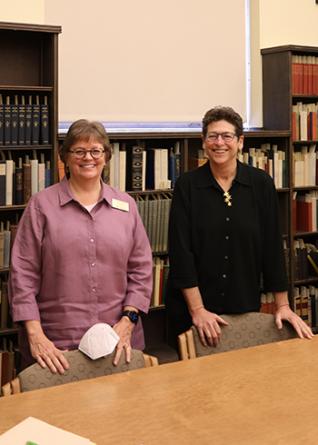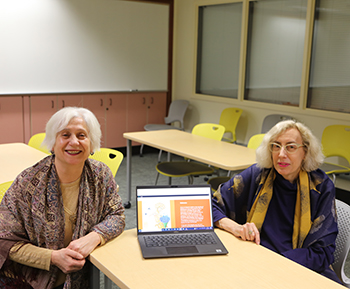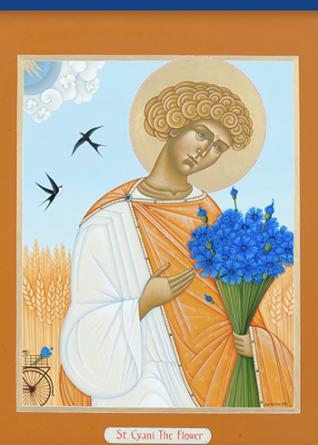Librarians at the University of Oregon are dedicated to providing research support to students and faculty members. From collaborating with faculty members to aid undergraduate students on class projects to providing instruction in data management tools to being embedded in study abroad programs, UO librarians contribute to research in exciting, though sometimes less visible ways. Here, we are spotlighting two research-based endeavors our librarians have been supporting.
Learning Firsthand About LGBTQ+ History
 Curator of Manuscripts Librarian Linda Long and Women, Gender, and Sexuality Studies Professor Judith Raiskin co-taught “Out in the Archives”—an honors college course focused on LGBTQ+ topics. Students got to explore several LGBTQ+ collections available in the UO Libraries’ Special Collections and University Archives including the Oregon Lesbian Land Collections, the papers of Lesbian artist and photographer Tee Corine, and the papers of Police Officer Earl Biggs who arrested gay men in the 1930s but after corresponding with sexologist Alfred Kinsey, changed his outlook.
Curator of Manuscripts Librarian Linda Long and Women, Gender, and Sexuality Studies Professor Judith Raiskin co-taught “Out in the Archives”—an honors college course focused on LGBTQ+ topics. Students got to explore several LGBTQ+ collections available in the UO Libraries’ Special Collections and University Archives including the Oregon Lesbian Land Collections, the papers of Lesbian artist and photographer Tee Corine, and the papers of Police Officer Earl Biggs who arrested gay men in the 1930s but after corresponding with sexologist Alfred Kinsey, changed his outlook.
On the first day of the class in fall term, students were informed about the wide variety of collections the library has to offer in relation to LGBTQ+ topics. Then they chose what subject they wanted to research. The various assignments throughout the term—creating an outline, writing an abstract, meeting with Professor Raiskin to fine-tune their thesis, and finally writing a research paper—all required students to navigate and get familiar with primary sources.
As an expert in working with manuscripts in Special Collections, Linda Long was there to guide the class on how to use these primary sources to conduct research. She helped students search through collections based on their research topics, taught them how to request physical copies of sources, assisted in reading complex handwriting, and instructed them on how to handle these rare papers properly— to maintain their good condition so they could be used for years to come.
Long emphasized that it is illuminating to work with primary sources and to discover information that you cannot find anywhere else.
“It is such an eyeopener for [the students] to have a source that is not just a textbook that has been assigned to them. They get to handle the actual documents and to make their own interpretations from what they are reading—you can see the excitement in the class,” said Long.
 Students in this course understood the rarity of these primary sources and appreciated the fact that that could only be found in our very own library. Not only were these various journals, letters, and correspondence used to support their research but, they also connected students to people related to these sources. Through the special collections and archives, one student was connected to a DJ from a women’s radio show, from the 80’s and 90’s, and she lent him her personal collection of taped recordings. Utilizing university curated primary sources opened students up to the possibilities of personal archives while doing research. It allowed them to look at research in a whole new light.
Students in this course understood the rarity of these primary sources and appreciated the fact that that could only be found in our very own library. Not only were these various journals, letters, and correspondence used to support their research but, they also connected students to people related to these sources. Through the special collections and archives, one student was connected to a DJ from a women’s radio show, from the 80’s and 90’s, and she lent him her personal collection of taped recordings. Utilizing university curated primary sources opened students up to the possibilities of personal archives while doing research. It allowed them to look at research in a whole new light.
Several students from “Out in the Archives” are hoping to present their work in the UO’s upcoming Undergraduate Research Symposium on May 25, 2023.
Student Internship Highlights the Slavic Immigrant Artist Population in the Northwest
 Slavic Immigrant Artists in the Northwest (SIAN)—a new internship program offered to both undergraduate and graduate students at the University of Oregon—launched this January. UO Libraries’ Slavic Librarian Heghine Hakobyan and College of Arts and Sciences’ Comparative Literature and Russian Professor Jenifer Presto are co-directing the project.
Slavic Immigrant Artists in the Northwest (SIAN)—a new internship program offered to both undergraduate and graduate students at the University of Oregon—launched this January. UO Libraries’ Slavic Librarian Heghine Hakobyan and College of Arts and Sciences’ Comparative Literature and Russian Professor Jenifer Presto are co-directing the project.
The Slavic Immigrant Artists community that currently resides in the Northwest is not known by many, but this project wants to change that.
“When we think about Slavic immigrant artists in the U.S., we tend to think New York, L.A., maybe San Francisco. But I don’t think people necessarily think of Oregon and Washington,” said Presto.
Hakobyan emphasized that the SIAN project also aims to celebrate the success stories of these artists. Coming from various parts of the world, these individuals have managed to bring their inspiration to this country and thrive creatively.
Students enrolled in the internship are asked to:
- Choose a Slavic Artist—either one they find or from the robust list Hakobyan has curated over time
- Conduct an interview with the artist
- Create a gallery of their chosen artist’s work
 Galleries could be anything from photos of an artist's sculptures to collections of playbills from a performer’s career. Essentially, the artists’ work can be highlighted in whatever way the student chooses to best showcase it. When completed, these profiles get published on the SIAN website to be shared with other students, researchers, and the general public.
Galleries could be anything from photos of an artist's sculptures to collections of playbills from a performer’s career. Essentially, the artists’ work can be highlighted in whatever way the student chooses to best showcase it. When completed, these profiles get published on the SIAN website to be shared with other students, researchers, and the general public.
To be a part of this internship program, students are required to enroll in the course RUSS 404 and 604: Slavic Immigrant Artists in the Northwest. The entire class meets twice per term: at the beginning to introduce students to how the internship works and at the end to reflect and share everyone’s finished projects.
Hakobyan and Presto have divided the internship work into sections with deadlines every two weeks and meeting with interns individually to ensure students are on track to finish their galleries by the end of the term. On top of these regular “check-ins,” both directors are readily available to meet with students to guarantee they have any additional support and guidance they might need.
The work for the SIAN project is extremely tangible—students are working and interacting directly with the contemporary artists they’re researching. Not only does this project focus on research but, it also asks students to be journalists, asking questions, being curious, and establishing a relationship with the artist.
“It's a very different enterprise to work with living artists and to be able to test some of your ideas by speaking with them. In some ways, that’s really exciting. It’s a different kind of critical process,” said Presto.
SIAN will be offered again in fall term to continue building a curated collection of Slavic Immigrant Artists for other researchers and art lovers to access.
—By Kate Lloyd, communications assistant, UO Libraries Communications
